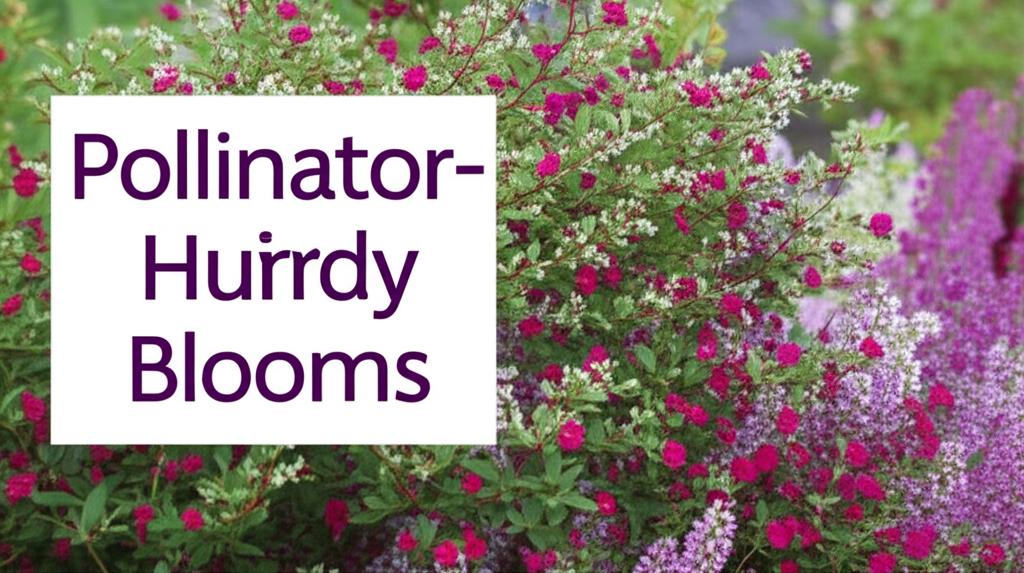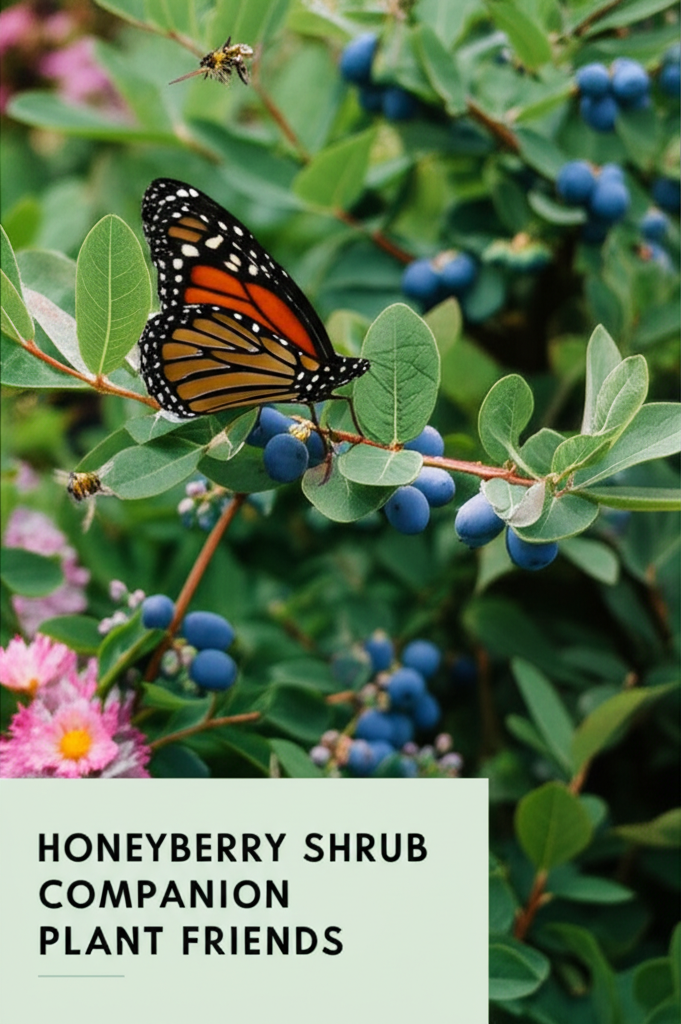The Sweet Symphony of Honeyberry and Companion Blooms
The honeyberry shrub (Lonicera caerulea), also known as Haskap or Edible Honeysuckle, is a remarkable plant offering early spring blossoms, delicious antioxidant-rich berries, and a resilient nature. Its early flowering habit makes it a crucial food source for emerging pollinators after the winter dormancy. To maximize the benefits of your honeyberry patch, creating a supportive ecosystem with well-chosen companion flowering plants is key. These companions not only attract a wider array of pollinators but also contribute to soil health, pest deterrence, and overall garden beauty. This guide explores the best flowering plants to pair with your honeyberry shrubs, fostering a thriving habitat for bees, butterflies, and other beneficial insects.
Understanding the Honeyberry’s Needs and Pollination Partners

Honeyberry plants are self-infertile, meaning they require at least two different varieties planted in proximity for successful fruit production. This cross-pollination is facilitated by insects, primarily bees. Their early bloom period, often starting in early to mid-spring before many other plants have awakened, makes them a vital early food source. Therefore, companion plants that bloom concurrently or slightly overlap with the honeyberry’s flowering period are ideal.
The ideal companion plant will:
- Attract similar pollinators: Plants that draw in bees, especially bumblebees, are crucial for honeyberry pollination.
- Provide sequential or overlapping blooms: This ensures a continuous food supply for pollinators throughout the spring and summer.
- Enhance soil health: Some plants can improve soil structure, nutrient availability, or deter pests.
- Offer visual appeal: A diverse planting scheme creates a more dynamic and attractive garden.
- Not compete aggressively: Companions should complement, not overpower, the honeyberry.
Key Pollinator-Attracting Companion Plants for Honeyberry
When selecting companion plants, consider their blooming times, pollinator attraction capabilities, and growth habits. Here are some of the top choices to create a synergistic ecosystem around your honeyberry shrubs:
Early Spring Bloomers (Concurrent with Honeyberry)
These plants are vital for supporting pollinators during the honeyberry’s initial flowering phase.
- Borage (Borago officinalis): This annual herb is a magnet for bees, particularly bumblebees. Its star-shaped blue flowers are edible and have a cucumber-like flavor. Borage readily self-seeds, ensuring its return year after year.
- Comfrey (Symphytum officinale): While known for its medicinal properties, comfrey is also an excellent pollinator attractor with its bell-shaped purple or pink flowers. It’s a deep-rooted plant that draws up nutrients from lower soil levels, making its fallen leaves beneficial compost material. Ensure you choose sterile varieties like ‘Bocking 14’ to prevent aggressive spreading.
- Primroses (Primula spp.): Many primrose varieties offer vibrant colors and bloom early in spring, providing nectar and pollen when other food sources are scarce. They prefer partial shade and moist soil, which can often be found under or near larger shrubs.
- Forget-Me-Nots (Myosotis spp.): These charming blue flowers are a delightful addition to the spring garden. They attract small bees and hoverflies and can naturalize easily in moist, shaded areas.
Mid-Spring to Late Spring Bloomers (Overlapping with Honeyberry Peak Bloom)
As honeyberry flowering continues and the berry set begins, these plants provide a continued food source.
- Chives (Allium schoenoprasum): The spherical purple flower heads of chives are incredibly attractive to bees. Their mild oniony flavor also makes them a culinary delight. They are drought-tolerant once established and can be divided and replanted easily.
- Poppies (Papaver spp.): From the delicate California Poppy to the vibrant Oriental Poppy, these flowers offer abundant pollen. Many varieties are annuals or short-lived perennials that self-seed readily.
- Columbine (Aquilegia spp.): With their unique spurred blossoms, columbines attract a variety of pollinators, including long-tongued bees and hummingbirds. They thrive in partial shade and prefer well-drained soil.
- Creeping Thyme (Thymus serpyllum): This low-growing herb forms a fragrant carpet of tiny pink to purple flowers that are irresistible to bees. It’s also drought-tolerant and can be used as a groundcover, suppressing weeds.
Late Spring to Early Summer Bloomers (Supporting Pollinator Health and Berry Development)
These plants ensure pollinators have sustenance as the honeyberry fruits develop and ripen.
- Lavender (Lavandula spp.): A quintessential pollinator plant, lavender’s fragrant purple spikes are a bee favorite. It’s drought-tolerant and prefers full sun and well-drained soil, which is also ideal for honeyberries in many climates.
- Salvia (Salvia spp.): Many varieties of Salvia, especially those with blue or purple flowers, are highly attractive to bees and butterflies. They offer continuous blooms throughout the summer if deadheaded.
- Echinacea (Coneflower) (Echinacea spp.): Coneflowers are robust perennials with daisy-like flowers that provide nectar and pollen for a long period. They are drought-tolerant and attract butterflies and bees.
- Coreopsis (Tickseed) (Coreopsis spp.): These cheerful yellow flowers are excellent for attracting bees and butterflies. They are hardy, long-blooming, and prefer full sun.
Key Facts and Comparison Table
Here’s a look at some of the recommended companion plants, highlighting their key characteristics relevant to honeyberry cultivation and pollinator support:
| Plant Name | Scientific Name | Bloom Time | Primary Pollinators Attracted | Sun Exposure | Soil Preference | Growth Habit |
|---|---|---|---|---|---|---|
| Borage | Borago officinalis | Late Spring – Summer | Bees (especially bumblebees) | Full Sun | Well-drained | Annual, self-seeds |
| Comfrey | Symphytum officinale | Late Spring – Summer | Bees, Hoverflies | Partial Shade to Full Sun | Moist, fertile | Perennial, deep-rooted |
| Chives | Allium schoenoprasum | Late Spring – Early Summer | Bees | Full Sun | Well-drained | Perennial, clumping |
| Lavender | Lavandula spp. | Late Spring – Summer | Bees, Butterflies | Full Sun | Well-drained, sandy | Shrubby perennial |
| Echinacea (Coneflower) | Echinacea spp. | Summer | Bees, Butterflies | Full Sun | Well-drained | Perennial |
| Columbine | Aquilegia spp. | Mid-Spring – Early Summer | Bees, Hummingbirds | Partial Shade | Moist, well-drained | Perennial |
Designing Your Pollinator Garden Around Honeyberries
The arrangement of your companion plants can significantly impact their effectiveness and the overall health of your garden.
Planting Considerations:
- Proximity: Plant companions close enough to the honeyberries to facilitate cross-pollination by bees, but not so close that they impede access to the honeyberry blossoms or create overcrowding. A radius of a few feet around each honeyberry shrub is generally effective.
- Mass Planting: Pollinators are more likely to visit drifts or clumps of flowers rather than single specimens. Planting companions in groups of three or more of the same species can increase their visibility and attractiveness.
- Height Variation: Use plants of varying heights to create visual interest and cater to different pollinator preferences. Taller plants can be placed behind honeyberries, while lower-growing options can act as groundcover or border plants.
- Layering Blooms: Aim for a succession of blooms from early spring through summer. This ensures a continuous food source, supporting a healthy pollinator population throughout the growing season.
- Soil and Sun Matching: While honeyberries generally prefer full sun and well-drained soil, some companions, like comfrey or columbine, can tolerate or even prefer partial shade. Choose locations that best suit the needs of both the honeyberry and its companions. Consider planting shade-tolerant companions on the north side of honeyberry bushes.
Beneficial Interactions:
Some companion plants offer additional benefits beyond just attracting pollinators:
- Pest Deterrence: Plants like chives and garlic (though not flowering, their foliage can be beneficial nearby) can deter certain pests with their strong scents.
- Ground Cover: Low-growing plants such as creeping thyme can help suppress weeds, retain soil moisture, and prevent soil erosion around the base of the honeyberry shrubs.
- Nutrient Cycling: Comfrey’s deep roots can bring nutrients to the surface, and its leaves, when composted, create nutrient-rich material.
Steps to Creating a Thriving Honeyberry Ecosystem
Implementing a companion planting strategy for your honeyberry shrubs is a straightforward process.
| Step | Description |
|---|---|
| 1. Assess Your Site | Evaluate the sunlight, soil type, and moisture levels in your honeyberry planting area. Note the bloom times of your existing honeyberry varieties. |
| 2. Select Companion Plants | Choose plants based on their bloom times, pollinator attraction, and compatibility with your site conditions. Aim for diversity in species and bloom periods. |
| 3. Prepare the Planting Area | Amend the soil with compost if necessary to improve drainage and fertility. Remove any competing weeds. |
| 4. Plant Companions | Place companion plants around the honeyberry shrubs, considering height, bloom time, and mass planting for maximum impact. Ensure adequate spacing for growth. |
| 5. Mulch and Water | Apply a layer of organic mulch around the base of the new plants to retain moisture and suppress weeds. Water thoroughly after planting. |
| 6. Ongoing Care | Water regularly during dry periods, especially for young plants. Deadhead flowering plants to encourage reblooming and monitor for any signs of pests or diseases. |
Pros and Cons of Companion Planting with Honeyberries
Companion planting offers numerous advantages but also requires careful consideration.
| Pros | Cons |
|---|---|
| Enhanced Pollination: Attracts a wider variety of pollinators, leading to better fruit set and yield in honeyberries. | Competition for Resources: Some companions may compete with honeyberries for water, nutrients, and sunlight if not planted strategically. |
| Extended Bloom Season: Provides continuous nectar and pollen sources for pollinators throughout spring and summer. | Potential for Overcrowding: Fast-growing or aggressive companions can outcompete or shade out honeyberry plants. |
| Biodiversity: Creates a more diverse and resilient garden ecosystem, supporting beneficial insects and potentially deterring pests. | Increased Maintenance: Managing multiple plant species may require more time for weeding, watering, and pruning. |
| Aesthetic Appeal: Adds color, texture, and visual interest to the garden. | Specific Needs: Some companion plants have specific soil or light requirements that may not perfectly align with honeyberries. |
| Soil Improvement: Certain companions can improve soil structure and fertility through their root systems and decomposition. | Pest or Disease Transfer: In rare cases, companion plants could act as hosts for pests or diseases that affect honeyberries. Careful selection is crucial. |
Conclusion: A Flourishing Partnership
By thoughtfully selecting and integrating companion flowering plants with your honeyberry shrubs, you can create a vibrant, productive, and beautiful garden that buzzes with life. These partnerships not only boost honeyberry yields but also contribute to a healthier local ecosystem by supporting crucial pollinator populations. Embrace the synergy of a well-designed pollinator garden and enjoy the sweet rewards of your efforts, from early spring blooms to delicious summer berries. A little planning goes a long way in cultivating a true haven for nature’s hardest workers.


